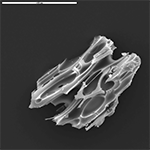 IMAGE COPYRIGHT
IMAGE COPYRIGHT Back in Time
Our world is changing rapidly, but how do we know what the past looked like?
Use a microscope to see and learn to identify a range of fossils, including fossil pollen and insects. These can be used to explore evidence of past habitat change and to think about the impacts of climate change on present environments.
There will also be some mystery fossils that you can guess what they are and what they tell us about environmental change.
Use a microscope to see and learn to identify a range of fossils, including fossil pollen and insects. These can be used to explore evidence of past habitat change and to think about the impacts of climate change on present environments.
There will also be some mystery fossils that you can guess what they are and what they tell us about environmental change.
You may also like

Rise Higher: songs of hope promoting good mental health
Hidden Gems Hampshire is a group of diverse individuals from Southampton and the New Forest. They came together with poetry, songwriting and musical talent; donating their time ...Read More
Highfield Campus

Who is in your family?
Families come in different shapes and sizes. Some parents are mums. Other parents are dads. Some parents are nomies or rens. There are lots of different names for grandparents: t ...Read More
Highfield Campus
 - v2.jpg)
